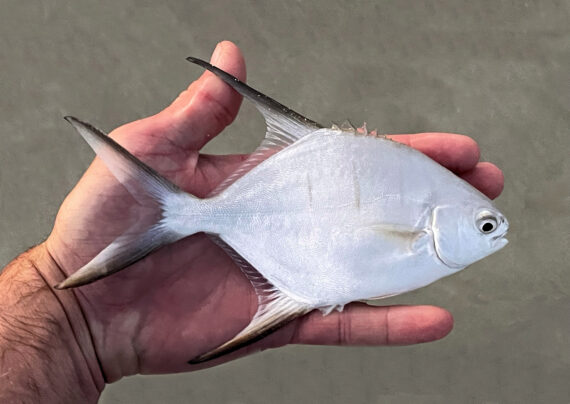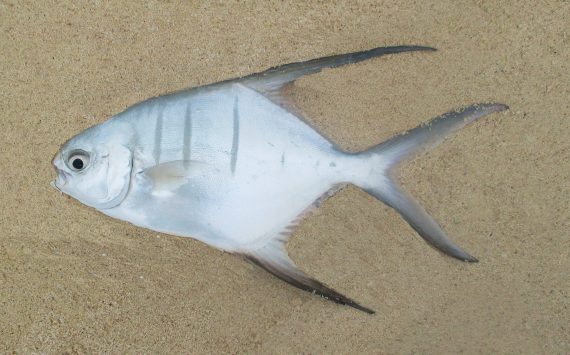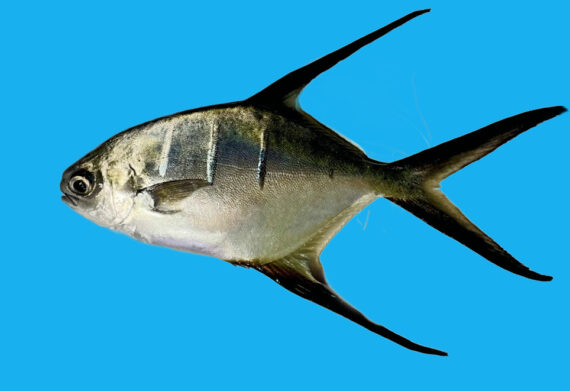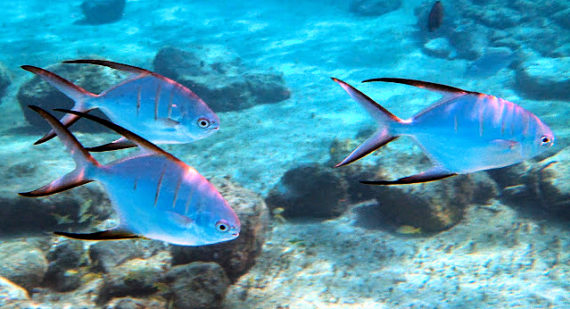Palometa, Trachinotus goodei
 Palometa, Trachinotus goodei. Fish caught from coastal waters off Miami Beach, Miami, Florida, July 2021. Length: 25 cm (10 inches). Catch, photograph and identification courtesy of Luke Ovgard, Klamath Falls, Oregon.
Palometa, Trachinotus goodei. Fish caught from coastal waters off Miami Beach, Miami, Florida, July 2021. Length: 25 cm (10 inches). Catch, photograph and identification courtesy of Luke Ovgard, Klamath Falls, Oregon.
 Palometa, Trachinotus goodei. Fish caught off the beach at Playa del Carmen, Yucatán, Quintana Roo, February 2016. Length: 28 cm (11 inches). Catch, photograph and identification courtesy of George Brinkman, Guelph, Ontario, Canada.
Palometa, Trachinotus goodei. Fish caught off the beach at Playa del Carmen, Yucatán, Quintana Roo, February 2016. Length: 28 cm (11 inches). Catch, photograph and identification courtesy of George Brinkman, Guelph, Ontario, Canada.
 Palometa, Trachinotus goodei. Fish caught from coastal waters off Fort Lauderdale, Florida, March 2023. Length: 30 cm (12 inches). Catch and photograph courtesy of Faith Hubsch, Fort Lauderdale, Florida.
Palometa, Trachinotus goodei. Fish caught from coastal waters off Fort Lauderdale, Florida, March 2023. Length: 30 cm (12 inches). Catch and photograph courtesy of Faith Hubsch, Fort Lauderdale, Florida.
 Palometa, Trachinotus goodei. Underwater photograph taken in Yal-Ku, Quintana Roo, Yucatán, March 2017. Photograph courtesy of Chery Anne Orrell, Montrose, British Columbia, Canada.
Palometa, Trachinotus goodei. Underwater photograph taken in Yal-Ku, Quintana Roo, Yucatán, March 2017. Photograph courtesy of Chery Anne Orrell, Montrose, British Columbia, Canada.
 Palometa, Trachinotus goodei. Underwater photograph taken in Bonaire, December 2019. Photograph and identification courtesy of Bob Hillis, Ivins, Utah.
Palometa, Trachinotus goodei. Underwater photograph taken in Bonaire, December 2019. Photograph and identification courtesy of Bob Hillis, Ivins, Utah.
The Palometa, Trachinotus goodei, is a member of the Jack or Carangidae Family, and is known in Mexico as pámpano listado. This is perhaps the most beautiful fish found in Mexican waters of the Atlantic Ocean. There are twenty global members of the genus Trachinotus, of which seven are found in Mexican waters, three in the Atlantic and four in the Pacific Ocean.
The Palometa has a diamond-shaped strongly compressed bodies with similar upper and lower profiles and a depth that is 38% to 42% of standard length. They have an overall silver coloration with 2 to 5 prominent narrow dark bars on their sides followed by 2 or 3 dark spots. Their fins are dark. Their snout is bluntly pointed and extendable and their mouth reaches under the eyes. Their anal fin has two isolated standalone spines followed by 1 spines and 16 to 18 rays; their caudal fin has a slender base and it deeply forked; their first dorsal fin has 6 short isolated spines; their second dorsal fin has 19 or 20 rays; and, their pectoral fin is shorter than head length. They have long pointed anal and dorsal fin lobes with anal and dorsal fin bases of equal length. They have 5 to 7 gill rakers on the upper arch and 8 to 14 gill rakers on the lower arch. They do not have finlets or scutes. Their body is covered with small oval scales.
The Palometa is a coastal pelagic species found demersal in the surf zone along beaches, vegetated bottoms, and around reefs at depths up to 30 m (100 feet). They reach a maximum of 51 cm (20 inches) in length. As of January 1, 2024, the International Game Fish Association world record stood at 0.81 kg (1 lb 12 oz) with the fish caught in coastal waters off Texas in June 2006. The Palometa is poorly studied with very limited information available about their lifestyle and behavioral patterns including specific details on age, growth, longevity, movement patterns, diet, habitat use, and reproduction.
The Palometa is a resident of all Mexican waters of the Atlantic with the exception that they are absent from of the Caribbean.
The Palometa is easy to identify and cannot be confused with other species found in the Atlantic. It is, however, very similar to the Gafftopsail Pompano, Trachinotus rhodopus (Pacific Ocean species, with a slightly more elongated body, darker fins, and longer and slender caudal fin lobes).
From a conservation perspective the Palometa is currently considered to be of Least Concern with stable, widely distributed populations. They are fairly common in the surf around the Yucatán and can be caught from shore with some regularity. They are considered excellent table fare, however, the majority of commercial fish are farm raised.